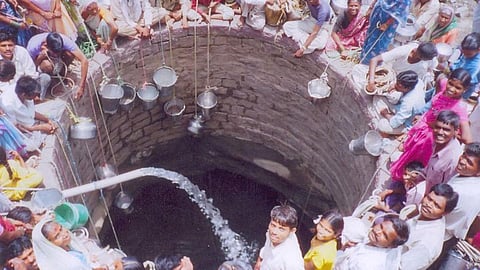
- Topics
- Feature
- Opportunities & Events
- About
- Hindi Portal
- Data
- Topics
- Feature
- Opportunities & Events
- About
- Hindi Portal
- Data

With an attempt to contain the spread of deadly Covid-19, Indian government had announced a complete nation-wide lockdown from March 25 onwards. For the first time, the provisions of the National Disaster Management Act, 2005, were invoked since the law came into being after the 2004 tsunami. The National Executive Committee of the National Disaster Management Authority (NDMA) issued guidelines for these 21 days – the first phase of the lockdown. In the third phase, the lockdown had been extended till May 17. But this time, authorities have divided districts into red, orange and green zones based on the severity of the spread and have issued separate guidelines for these zones.
The broad legal framework under which the Union and State governments are undertaking actions to control the spread is that of the 2019 National Disaster Management Plan that deals considerably with biological disaster and health emergency. The plans related to disaster management in India have terribly failed in the past while dealing with ‘natural hazards’ like earthquake, floods, cyclones, bushfires, droughts, cloud burst, famine etc.
Time and again, we have seen that the prevention and preparedness strategies are limited to paper with very few exceptions. Many of these disasters are recurring – they affect certain states every year (Bihar, Assam floods for example) yet every year lives are lost, infrastructure is damaged, livelihoods are affected, and people have to suffer on their own. This pandemic, with no past experience, has caught the country and the administration completely off guard.
Unlike the ‘usual’ disasters, this pandemic has a drastically different nature – the sudden onset and contagious nature has created panic among people. With no vaccine available, the number of cases in India has grown to almost 90,000 as on May 17, 2020. By implementing lockdown, government was able to restrict the movement of 1.3 billion population and with that it managed to contain the spread. No one was prepared to cope with the impact – neither the public nor the government. Lockdown, however, helped the authorities buy time and build the resources required to handle the situation.
The basic rule for managing disasters is to be prepared before they arrive, which clearly isn’t the case here. The urban areas and the metropolitans still managed to get hospitals, medical aid, quarantine facilities, access to right information but what about our rural areas?
Osmanabad district in Maharashtra has been drought-prone for many decades. The district website has a detailed Standard Operating Procedure (SOP) for handling flood, yet its Disaster Management Plan deals with epidemics only in a perfunctory manner with a small section that mentions water borne diseases common in the rainy season.
Before droughts, Osmanabad was severely affected by the 1993 Latur earthquake that had left many sections of its population extremely vulnerable. Their income, livelihood, social status and psycho-social well-being was severely affected and left a long term impact on overall well-being of the village communities. Before they could recover completely from the earthquake, they were hit by drought, which continued to be their prime concern till date. Water scarcity and complex issues around it form a part of their daily lives.
Now, they are exposed to this novel coronavirus. It is a rare phenomenon for the village communities and due to low literacy and lack of awareness, there are rumours, false or incomplete information related to Covid-19 that has created panic among them. Most importantly, there is a need to acknowledge the fact that lack of awareness along with limited supply of clean water and ill-equipped and insufficient public health centres and district hospitals, put rural areas at increased risk of spread.
Now, with workers returning to their villages, and in great numbers, there are chances of them carrying the virus to these hinterlands. In such situations, gram panchayats and allied institutions have a critical role to play while addressing the local needs and solving issues. It is, therefore, the responsibility of the policy makers to ensure that local institutions become capable of taking the lead through proactive interventions.
Covid-19, like most other disasters, has given us an opportunity to rethink our disaster management policies and the top-down approach that it follows.
Once the lockdown is lifted, there is a need to move forward from the ‘build back better’ and follow the ‘build better’ approach because back is not always sustainable, inclusive, relevant, resilient, equitable and justifiable.
To achieve this, changes are required at multiple levels – right from policy making to political and from psychosocial to technological interventions. Our disaster management strategies need to be in sync with the development plans to ensure well-being of humans without further damaging the environmental systems.
Priyanka Tajane is a disaster management professional currently working as a Programme Manager on ‘Disaster and Beyond’ Project at the Tata Institute of Social Sciences, Mumbai.